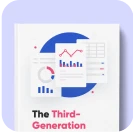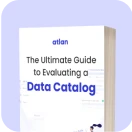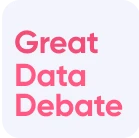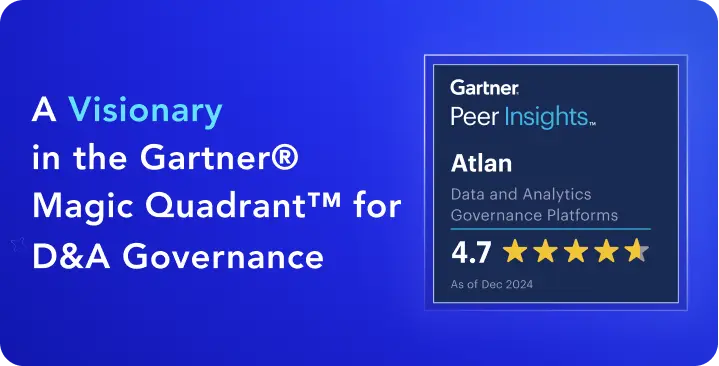Data Domain Data Governance: The Solution to Governance at Scale?
Share this article
How much of your organization’s data are you using?
A report from Splunk estimates that up to 55% of enterprise data is untapped “dark” data with no meaning assigned to it. That’s a lot of value being left on the table.
Dark data exists because, with the expansion of cloud systems, it’s difficult to keep your teams from breaking off and creating information silos. Team initiative and autonomous development are great. However, these need to be balanced against cross-org data accessibility and collaboration.
See How Atlan Simplifies Data Governance – Start Product Tour
The solution to this conundrum? Data domain architecture.
Data domain architecture is a way to structure your data governance with centralized cataloging and governance to support standards and data discoverability while cultivating autonomous development and collaboration between teams.
In this article, we’ll explain what data domains are and how data domain data governance can make it easier to create governed, secure, and compliant data sets.
Table of Contents #
- What is a data domain?
- Data domain examples
- Advantages of data domain data governance
- How data domain data governance works
- What Atlan offers for data domain data governance
- Data domain data governance made easy
- Related reads
What is a data domain? #
A data domain is a logical grouping of data products within a specific business domain or business entity. Data domain architecture breaks your data products into groups and subgroups relevant to your organization’s goals while decentralizing their ownership. These curated data products then empower your data consumers to easily discover data assets, quickly get the context they need, and collaborate more efficiently.
- Defining domains is flexible according to your needs. For example, you could create separate groups for finance data products and sales data products. Or, you could group your data products by the sales region they cover.
- Data domain architecture is designed to let domain owners manage their own specific data domains — for example, letting your finance teams own the pipelines, transformations, storage, and contracts of the data products they build and use.
As a result, decentralized domain ownership makes your data governance much more scalable.
Data domain examples #
Data domain definitions depend on the structure of your organization; ideally, data domains will map how data fits into your operations. Three common data domain structures to think about when defining your own specific context are domain by pipeline, domain by operation, and domain by usage.
Domain by pipeline #
In this domain architecture, you group data products by their start and end points. If you have data that comes in from a regular API call to an app and is processed into an analytics dashboard, all the data connecting the app to the dashboard will be in one group. If a different call to the same app gets sent to another sink, it will be in a different group.
- Pipeline architecture is most effective if you have lots of distinct pipelines running at the same time. Labeling products by their pipeline helps track the relations of data as you work with it.
- Keep in mind: These domain definitions can become confusing and convoluted if you have an integrated system where a single data object will be moved and modified across many different pipelines.
Domain by operation #
In this domain architecture, you group your data by where it is in the data product development process:
- Is it raw data?
- Is it in the ETL stage?
- Is it ready for analysis?
Operation architecture is best for organizations with a large volume of data moving consistently through analytics pipelines.
- Tracking each data object’s current development stage helps teams stay focused when lots of objects are coming across their desks.
- Keep in mind: When your primary goal is specific data usage, operation-oriented domain architecture is likely not the best fit. Organizations with varied data that gets treated differently depending on its function may find that operation domains are too general to provide the insights they need.
Domain by usage #
In this domain architecture, data gets grouped by how it’s used in your organization.
- For example, data used by finance teams would be in one data domain, while data used by marketing teams would be in another.
- Usage architecture helps organize data products used in day-to-day operations. Usage domains give teams context for the data they encounter — and helps them discover data products from across the organization, improving collaboration.
- Keep in mind: Usage-based domain architectures can be complicated to implement. Effective usage domains require decentralized governance where teams are tracking, tagging, and sharing the data products they create.
Advantages of data domain data governance #
Data domain data governance has several advantages that simplify the data governance process:
- Fostering collaboration: Data domains provide context for your data products, making it easier to share and understand data. This added information makes your data products discoverable across different teams — breaking down silos and shining a light on dark data.
- Supporting policy: Grouping data helps apply governance policies at scale (and also supports data compliance). By breaking data into domains, you can have strong access controls on user PII, while having anonymized marketing data be more freely available for use in analytics.
- Enabling analysis: Domain tags give your data different dimensions when you are developing analysis strategies. A meaningful domain architecture lets you unlock the value of your data by providing new perspectives on the data products you already have.
How data domain data governance works: Examples #
To get a deeper understanding of how data domains connect with data governance, let’s look at our previous data domain approaches and see what they offer for data governance:
- Pipeline domains: Pipeline domains help in tracking the application of data policy. Knowing where data comes from — and where it is going — ensures end-to-end compliance with your organization’s data policies. Pipeline domains are your go-to architecture when policy adherence is critical at all times.
- Operation domains: Operation domains help organize workflows and maintain data quality. Knowing where data is in its development cycle makes sure you are using the right data at the right time. Operation domains are an optimal architecture when you have a large volume of data being shared and processed in different areas.
- Usage domains: Usage domains help teams understand where data products come from and what meaning they hold for the organization. Knowing where data fits optimizes collaboration when teams share data products with a full context and understanding of what those products mean. Usage domains are a good architecture when you have decentralized, collaborative teams independently working with data.
What Atlan offers for data domain data governance #
Atlan is a modern data catalog and data governance solution. Atlan’s AI-powered platform supports global entrerprises like NASDAQ and General Motors, providing them with the tools they need to govern their data at scale.
Atlan can help you implement data domain data governance with features like:
- Data product catalog: Atlan’s data catalog provides a hybrid approach with domain tooling — where teams can publish new data products to a centralized catalog governed by company standards. This makes data usage architecture easy to implement, allowing for powerful data domain architecture at scale.
- Natural language search: Atlan’s natural language search interface provides a “Google for your data,” enhancing data domains by bringing them into your data discovery processes. With intuitive interfaces, you can maintain complex domain architectures without your teams getting lost.
- Automated metadata management: Atlan’s active metadata management system allows you to create and maintain domain architectures at scale, providing metadata tagging suggestions and automatically flagging policy violations that you define.
With Atlan, you can easily define data domains that fit your organization with zero worry about complexity overload.
Data domain data governance made easy #
Data domain architecture breaks your data into logical groups, providing context for your data products. Defining domains that fit your organization’s needs enhances your data governance, helping to track your data through its lifecycle, keep your operations organized, and support collaboration between your teams.
Atlan’s data governance system offers leading catalog tools that you can use to define, manage, and automate data domain definitions. Atlan’s leading UI and natural language interface mean your teams can intuitively interact with your data domains, enhancing its impact on your governance — and banish dark data for good.
Want to see how Atlan can help your data domain governance? Schedule a demo.
Data domain data governance: Related reads #
- What is Data Governance? Its Importance & Principles
- Data Governance and Compliance: Act of Checks & Balances
- Data Governance Framework — Guide, Examples, Template
- Data Compliance Management in 2025
- BCBS 239 Compliance: What Banks Need to Know in 2025
- BCBS 239 Data Governance: What Banks Need to Know in 2025
- BCBS 239 Data Lineage: What Banks Need to Know in 2025
- HIPAA Compliance: Key Components, Rules & Standards
- CCPA Compliance: 7 Requirements to Become CCPA Compliant
- CCPA Compliance Checklist: 9 Points to Be Considered
- How to Comply With GDPR? 7 Requirements to Know!
- Benefits of GDPR Compliance: Protect Your Data and Business in 2025
- IDMP Compliance: It’s Key Elements, Requirements & Benefits
- Data Governance for Banking: Core Challenges, Business Benefits, and Essential Capabilities in 2025
- Data Governance Maturity Model: A Roadmap to Optimizing Your Data Initiatives and Driving Business Value
Share this article











